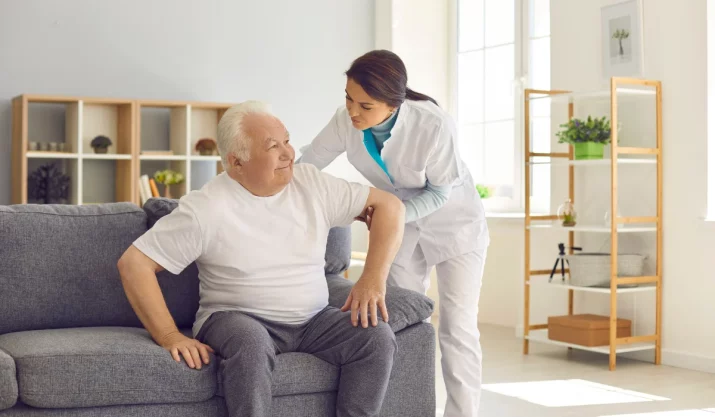Communicating About Mobility Needs: A Guide for Seniors and Caregivers

Table of Contents
- Key Takeaways
- Start the Conversation Early, Not During a Crisis
- Focus On Activities of Daily Living, Not Just Medical Conditions
- Ask About Feelings and Fears, Not Just Physical Limitations
- Bring Professionals Into the Conversation
- Use Local References to Make Support Feel More Approachable
- Reframe the Conversation Around Independence and Well-Being
- Let's Talk About Mobility Needs Before It Becomes a Safety Risk
Mobility changes can happen gradually or suddenly, but when they do, they affect nearly every aspect of daily life. Whether you’re an older adult noticing new mobility problems or a caregiver trying to support a loved one with a medical condition, the ability to talk openly about these challenges matters.
This guide is here to help you have those important conversations, early, clearly, and with confidence. We’ll walk you through how to discuss mobility needs in a way that prioritizes safety, dignity, and long-term comfort, with a focus on the real-world needs of Californians.
Key Takeaways
- Mobility conversations work best when started early, before a fall or emergency forces rushed and stressful decisions.
- Small changes in daily movement often signal the need for mobility aids, such as crutches, canes, or stair lifts.
- Emotional concerns like fear of falling are valid and should be discussed with therapists or trusted healthcare professionals.
- Local resources and California Mobility help older adults stay independent with custom stair lifts, ramps, and home solutions.
Start the Conversation Early, Not During a Crisis
Too often, families wait until a fall or injury forces the issue. That can lead to rushed decisions and unnecessary stress.
Instead, bring up mobility needs proactively—before there’s an urgent situation.
If your parent has started holding the railing more often or avoiding stairs altogether, these are signs worth noticing.
Ask open questions like:
- Do you feel safe walking from the bedroom to the bathroom at night?
- Would a handrail or rollator make that easier for you?
This helps make reduced mobility a topic that’s part of your ongoing personal care planning, not just a reaction to a scare.
Focus On Activities of Daily Living, Not Just Medical Conditions
While mobility impairments are often linked to specific medical conditions like Parkinson’s disease, multiple sclerosis, or cerebral palsy, they don’t always begin with a diagnosis.
Sometimes, it’s about small shifts in routine:
- Taking longer to get out of a chair
- Needing more rest after a short walk
- Skipping social outings because of poor balance
Instead of centering the conversation on illness, talk about physical activity and what’s become more difficult over time.
This makes room for a broader discussion about what support might help, whether that’s assistive technology or walking aids like canes or crutches.
Ask About Feelings and Fears, Not Just Physical Limitations
It’s not easy for someone to admit they’re having trouble getting around. People with disabilities or age-related mobility issues often experience a fear of falling, and with that comes anxiety, frustration, and even denial.
These feelings matter just as much as physical symptoms. Try asking:
- Are you feeling nervous about walking outside alone?
- Is there anything that makes you hesitate before going up the stairs?
Conversations like this give space to talk about concerns such as blood pressure drops, lack of upper body strength, or even the fear of needing a mobility device like a scooter or manual wheelchair.
By naming these fears, you open the door to finding solutions that respect the person’s autonomy and well-being.
Bring Professionals Into the Conversation
Sometimes, hearing it from a family member isn’t enough, especially if the topic feels sensitive. That’s where healthcare professionals can be helpful.
A physical therapist or occupational therapist can assess range of motion, balance, and strength, and make recommendations for mobility aids tailored to the individual’s needs.
In California, many providers work directly with Medicare to help cover the cost of assistive devices like rollators, types of canes, and mobility aids suited for daily use.
A therapist can also recommend home modifications like handrails or ramps for safer movement between rooms. These insights can extend a person’s ability to engage in physical activity and stay independent.
Use Local References to Make Support Feel More Approachable
Government programs and large-scale healthcare systems can feel abstract. But in California, there are real, local services that make a big difference for people with mobility disabilities.
You can find mobility device providers that offer free in-home consultations. Some counties even have government-backed programs that offer financial support for seniors making home safety improvements.
Whether you’re looking for walking sticks, types of wheelchairs, or assistance installing stair lifts and grab bars, knowing where to turn helps reduce the mental load that often comes with caregiving.
Reframe the Conversation Around Independence and Well-Being
No one wants to feel like they’re “giving up” by using a cane or accepting help. That’s why it’s crucial to frame these choices as empowering rather than limiting.
Rather than saying, “You can’t go up those stairs safely anymore,” try, “Adding a stair lift or handrail would help you keep using the second floor as long as you want.”
The right assistive technology doesn’t take away independence. It helps preserve it.
Whether it’s using walking aids, installing safety features, or adjusting daily routines to reduce risk, the goal is always fall prevention and sustaining a high quality of life.
Let’s Talk About Mobility Needs Before It Becomes a Safety Risk
At California Mobility, we understand that every person’s mobility journey is different, and so are the solutions. We offer a full range of home mobility products tailored to older adults and people with disabilities, including stair lifts, ramps, and home elevators that meet ADA standards.
Reach out today to see what a customized mobility solution could look like for your family, because comfort, dignity, and access should always go hand in hand.






